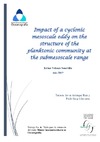Identificador persistente para citar o vincular este elemento:
https://accedacris.ulpgc.es/jspui/handle/10553/74799
| Título: | Impact of a cyclonic mesoscale eddy on the structure of the planktonic community at the submesoscale range | Autores/as: | Velasco Senovilla, Esther | Director/a : | Arístegui Ruiz, Javier Sangrá Inciarte, Pablo |
Clasificación UNESCO: | 251001 Oceanografía biológica 251007 Oceanografía física |
Palabras clave: | Áreas de afloramiento Fitoplancton marino Torbellinos (Mecánica de fluidos) |
Fecha de publicación: | 2017 | Proyectos: | Remolinos Oceanicos y de Posición Atmosferica (Roda): Dinámica y Monitorización de Remolinos Oceanicos en la Corriente de Canarias | Resumen: | Mesoscale and submesoscale features of associated with the eddy field located downstream of the island of Gran Canaria are studied to assess their impact on the structure and distribution of the planktonic community. This study shows hydrographic and biological information based on XBT (Expendable Bathythermographs) and biogeochemical Rosette-CTD casts at a high resolution (near submesoscale) crossing a cyclonic eddy and its marginal frontal regions. Along the transect 4 main features were monitored: the margin of a large anticyclonic eddy, a large cyclonic eddy (affected by a filament from the North Africa Upwelling System), the sharp front between the two eddies, and a small submesoscale anticyclonic eddy. The “Vertical Oceanic Pump” (VOP) in the zone is typified by two main mechanisms, eddy-pumping, generated by the cyclonic eddy, and ASC (ageostrophic secondary circulation), produced at the fronts. Both processes affect the physicochemical nature of the water column, encompassing nutrient distribution. The planktonic community, which includes bacteria, cyanobacteria (Synechococcus and Prochlorococcus), autotrophic picoeukaryotes, and heterotrophic and autotrophic nanoflagellates show a heterogeneous distribution close to the submesoscale range. The analysis suggests that physical forcing (eddy pumping and ASC) is the main reason for the distribution of organisms, together with the filament, which introduces upwelled waters modifying the concentration of nutrients and organisms. The greatest accomplishment of this study compared with other eddy field studies, is that we have used a smaller scale resolution to look in detail and understand the physical forcing on the planktonic community distribution, and hence in the VOP associated with mesoscale features. Our results suggest that processes at submesoscale have a large effect on biogeochemical processes in the ocean, where eddies and frontal structures are dominant. | Departamento: | Departamento de Biología | Facultad: | Facultad de Ciencias del Mar | Titulación: | Máster Universitario en Oceanografía por la Universidad de Cádiz, la Universidad de Las Palmas de Gran Canaria y la Universidad de Vigo | URI: | https://accedacris.ulpgc.es/handle/10553/74799 |
| Colección: | Trabajo final de máster |
En el caso de que no encuentre el documento puede ser debido a que el centro o las/os autoras/es no autorizan su publicación. Si tiene verdadero interés en el contenido del mismo, puede dirigirse al director/a o directores/as del trabajo cuyos datos encontrará más arriba.
Vista completaVisitas
162
actualizado el 14-dic-2024
Descargas
148
actualizado el 14-dic-2024
Google ScholarTM
Verifica
Comparte
Exporta metadatos
Los elementos en ULPGC accedaCRIS están protegidos por derechos de autor con todos los derechos reservados, a menos que se indique lo contrario.

